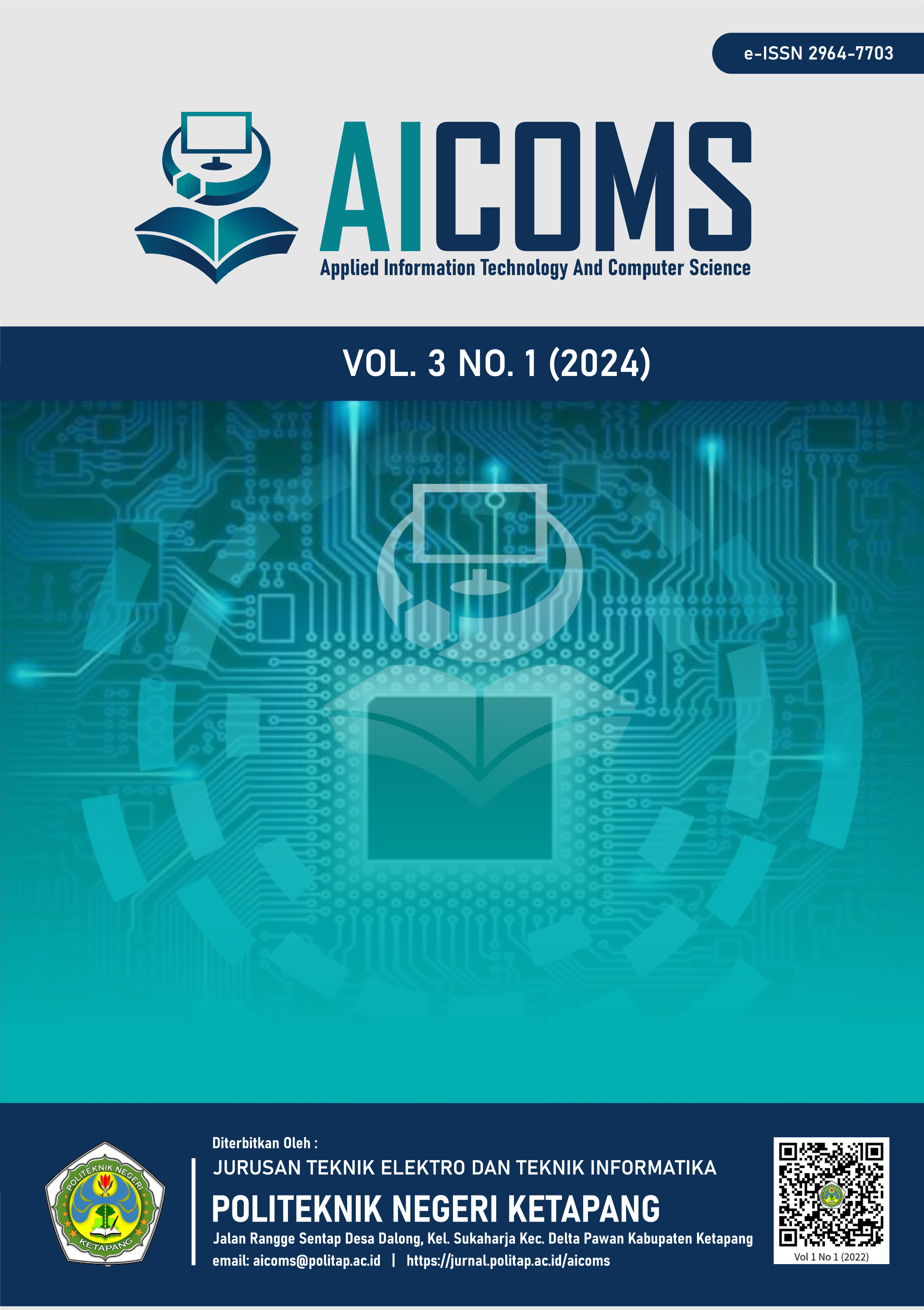Sentiment Analysis of Land Partner Applications Using the Naive Bayes Classifier and K-Nearest Neighbor Algorithms
 https://doi.org/10.58466/aicoms.v3i1.1542
https://doi.org/10.58466/aicoms.v3i1.1542
Keywords:
Sentimen Analisis, Mitra Darat, KNN, Data MiningAbstract
The transportation industry is now an important element as the times develop, especially for today's young generation. Mitra Darat itself is also one of these industries. An application that allows users to easily find out the bus departure schedule that they will take anywhere and anytime on their mobile device. Reviews are definitely given for every app available both positive and negative. With this, we are trying to conduct sentiment analysis research for the Mitra Darat application through reviewing comments from the Google Play Store so that we can identify sentiments related to the use of the Mitra Darat application, as well as provide valuable insights to land transportation service providers to understand user views and improve user services. from the results of our sentiment analysis. The algorithms we use are KNN and NBC. These two algorithms are commonly used by many people because of their expertise in classifying sentiment analysis data and are also popular among researchers. Based on our test results, it can be concluded that our sentiment analysis model designed using the NB algorithm displays higher accuracy performance than KNN. The accuracy of the NB model reached 99.28%, while KNN achieved an accuracy of 80%. This shows that the naïve Bayes algorithm is more suitable to obtain maximum accuracy compared to using k-nearest neighbors.
References
D. A. Warraihan, I. Permana, M. Mustakim, and R. Novita, “Analisis Sentimen Pengguna Transportasi Online Maxim Pada Instagram Menggunakan Naïve Bayes Classifier dan K-Nearest Neighbor,” J. Media Inform. Budidarma, vol. 7, no. 3, pp. 1134–1143, 2023, doi: 10.30865/mib.v7i3.6336.
S. Mandasari, B. H. Hayadi, and R. Gunawan, “Sentiment Analysis of Online Transportation Users Towards Grab Indonesia Services Using Multinomial Naive Bayes Classifier,” J-SISKO TECH (Jurnal Teknol. Sist. Inf. dan Sist. Komput. TGD), vol. 5, no. 2, p. 118, 2022, [Online]. Available: https://ojs.trigunadharma.ac.id/index.php/jsk/article/view/5635
Syahril Dwi Prasetyo, Shofa Shofiah Hilabi, and Fitri Nurapriani, “Analisis Sentimen Relokasi Ibukota Nusantara Menggunakan Algoritma Naïve Bayes dan KNN,” J. KomtekInfo, vol. 10, pp. 1–7, 2023, doi: 10.35134/komtekinfo.v10i1.330.
E. W. Sholeha, S. Yunita, R. Hammad, V. C. Hardita, and K. Kaharuddin, “Analisis Sentimen Pada Agen Perjalanan Online Menggunakan Naïve Bayes dan K-Nearest Neighbor,” JTIM J. Teknol. Inf. dan Multimed., vol. 3, no. 4, pp. 203–208, 2022, doi: 10.35746/jtim.v3i4.178.
V. K. S. Que, A. Iriani, and H. D. Purnomo, “Analisis Sentimen Transportasi Online Menggunakan Support Vector Machine Berbasis Particle Swarm Optimization,” J. Nas. Tek. Elektro dan Teknol. Inf., vol. 9, no. 2, pp. 162–170, 2020, doi: 10.22146/jnteti.v9i2.102.
N. P. G. Naraswati, R. Nooraeni, D. C. Rosmilda, D. Desinta, F. Khairi, and R. Damaiyanti, “Analisis Sentimen Publik dari Twitter Tentang Kebijakan Penanganan Covid-19 di Indonesia dengan Naive Bayes Classification,” Sistemasi, vol. 10, no. 1, p. 222, 2021, doi: 10.32520/stmsi.v10i1.1179.
A. M. Argina, “Penerapan Metode Klasifikasi K-Nearest Neigbor pada Dataset Penderita Penyakit Diabetes,” Indones. J. Data Sci., vol. 1, no. 2, pp. 29–33, 2020, doi: 10.33096/ijodas.v1i2.11.
D. Pajri, Y. Umaidah, and T. N. Padilah, “K-Nearest Neighbor Berbasis Particle Swarm Optimization untuk Analisis Sentimen Terhadap Tokopedia,” J. Tek. Inform. dan Sist. Inf., vol. 6, no. 2, pp. 242–253, 2020, doi: 10.28932/jutisi.v6i2.2658.
S. Syafrizal, M. Afdal, and R. Novita, “Analisis Sentimen Ulasan Aplikasi PLN Mobile Menggunakan Algoritma Naïve Bayes Classifier dan K-Nearest Neighbor,” MALCOM Indones. J. Mach. Learn. Comput. Sci., vol. 4, no. 1, pp. 10–19, 2023, doi: 10.57152/malcom.v4i1.983.
A. D. Wibisono, S. Dadi Rizkiono, and A. Wantoro, “Filtering Spam Email Menggunakan Metode Naive Bayes,” TELEFORTECH J. Telemat. Inf. Technol., vol. 1, no. 1, 2020, doi: 10.33365/tft.v1i1.685.
M. E. Lasulika, “Komparasi Naïve Bayes, Support Vector Machine Dan K-Nearest Neighbor Untuk Mengetahui Akurasi Tertinggi Pada Prediksi Kelancaran Pembayaran Tv Kabel,” Ilk. J. Ilm., vol. 11, no. 1, pp. 11–16, 2019, doi: 10.33096/ilkom.v11i1.408.11-16.
A. K. Fauziyyah, “Analisis Sentimen Pandemi Covid19 Pada Streaming Twitter Dengan Text Mining Python,” J. Ilm. SINUS, vol. 18, no. 2, p. 31, 2020, doi: 10.30646/sinus.v18i2.491.
F. Fathonah and A. Herliana, “Penerapan Text Mining Analisis Sentimen Mengenai Vaksin Covid - 19 Menggunakan Metode Naïve Bayes,” J. Sains dan Inform., vol. 7, no. 2, pp. 155–164, 2021, doi: 10.34128/jsi.v7i2.331.
M. Luthfi Bangun Permadi and R. Gumilang, “Penerapan Algoritma CNN (Convolutional Neural Network) Untuk Deteksi Dan Klasifikasi Target Militer Berdasarkan Citra Satelit,” J. Sos. Teknol., vol. 4, no. 2, pp. 134–143, 2024, doi: 10.59188/jurnalsostech.v4i2.1138.
A. Nugroho and Y. Religia, “Analisis Optimasi Algoritma Klasifikasi Naive Bayes menggunakan Genetic Algorithm dan Bagging,” J. RESTI (Rekayasa Sist. dan Teknol. Informasi), vol. 5, no. 3, pp. 504–510, 2021, doi: 10.29207/resti.v5i3.3067.





